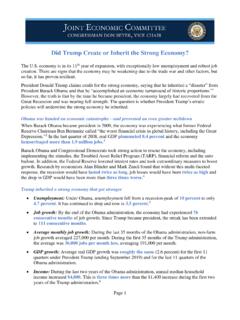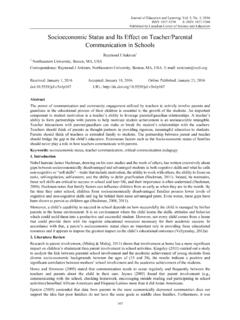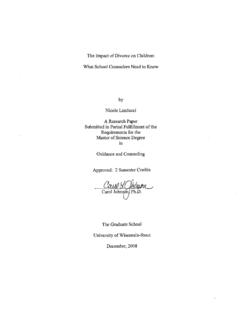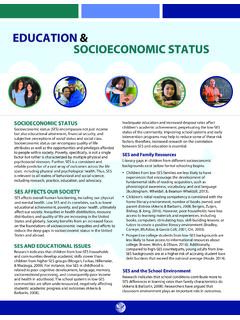Transcription of The Economic Benefits of Paid Leave: Fact Sheet
1 _____ Prepared by the Democratic Staff of the Joint Economic Committee The Economic Benefits of Paid Leave: Fact Sheet Paid Family and Medical Leave Paid family and medical leave allows workers to avoid having to choose between caring for their families and keeping their jobs. Providing workers with paid family and medical leave ensures that they are able to take extended leave, with pay, to care for a new child, recover from a serious illness or care for an ill family member, and that they are able to return to their job afterward. Economic studies have shown that access to paid family leave significantly increases the likelihood that workers will return to their jobs instead of dropping out of the labor force or spending time out of work to search for a new Workers are more likely to maintain their pre-leave wage level if they stay with the same employer than if they must find a new job.
2 That can raise their long-term Paid leave improves financial security for many disadvantaged groups that cannot afford to take unpaid leave. Currently, workers who are able to take advantage of unpaid leave are typically more educated and Recent research on California s paid leave policy has found that making paid leave more broadly available has especially helped minority women, those with less education, and unmarried women be able to afford to take more Paid leave can reduce the financial burden of illness that has been shown to lead to bankruptcies. Past research has found that a significant share of families that file for bankruptcy 25 percent of dual-income families and 13 percent of single -parent families do so after missing two or more weeks of work because they were sick or were caring for an ill family member, circumstances that would be covered by a paid family and medical leave Increasing access to paid leave can help children get a strong start in life.
3 Numerous studies have shown how critical the early childhood period is to making sure children have the opportunity to Research shows that mothers access to leave can have a positive impact on their children s health and development, and it can even affect long-term educational and earnings outcomes for The Economic Benefits of Paid Leave: Fact Sheet 2 _____ Prepared by the Democratic Staff of the Joint Economic Committee Offering paid leave improves business productivity by boosting employee morale and making it easier for businesses to retain skilled workers. Businesses gain from retaining workers with firm-specific knowledge and skills, and from not having to bear the sizable costs of finding and training new employees.
4 They benefit from increased productivity and higher levels of employee The median cost to employers of having to replace an employee is estimated to be about 21 percent of that employee s annual A survey of employers affected by California s paid family leave initiative found that only a small portion (fewer than 10 percent) reported adverse effects on profitability, turnover and Paid leave supports Economic growth. The economy Benefits from increasing access to paid leave because it helps workers stay in jobs that are a good match for them and where they have developed skills, which increases overall Paid leave has been shown to increase labor force participation and employment-to-population ratios, especially for The combination of increased productivity and labor force participation bolsters Economic growth.
5 Paid leave can reduce reliance on public assistance. According to one study, women who return to work after taking paid leave are about 40 percent less likely to receive public assistance in the year after giving birth than women who keep working and have no leave at Paid Family and Medical Leave and Women s Earnings Paid leave can help to close the gender pay gap by increasing women s attachment to the labor force and raising their long-term earnings trajectories. More than ever, families depend on women s earnings. In 2013, nearly two-thirds of families relied entirely or in part on a mother s income, and 45 million children lived with a mother who was in the labor On average, women s earnings still lag behind men s, which has consequences for the Economic security of women and their families .
6 Many factors affect the gap between men and women s pay, including the time women spend out of the workforce for caregiving The Economic Benefits of Paid Leave: Fact Sheet 3 _____ Prepared by the Democratic Staff of the Joint Economic Committee Women with access to paid leave are significantly more likely to return to their pre-leave employer and to maintain their pre-leave wages. They are able to build more tenure and experience in their jobs and maintain good job matches. This can raise their earnings and help close the pay One study found that, in California, a statewide paid family leave policy that took effect in 2004 led to women with infants taking more leave, especially among economically disadvantaged mothers.
7 The study also found that the policy may have helped women maintain or even increase their weekly hours among those with 1- to 3-year-old Another study found that new mothers with access to paid maternity leave were more likely to return to the workforce across multiple countries (United States, Great Britain and Japan).18 Research suggests one major reason the United States fell from 6th among OECD countries in female labor force participation in 1990 to 17th in 2010 is that the United States has not kept up with other nations in adopting family-friendly policies including paid Across OECD countries, each additional week of paid maternity leave is associated with an increase in labor force participation among young women ages 20 to 34 of about two-thirds of a percentage Paid Sick Leave Allowing employees to earn paid sick leave reduces presenteeism, or going to work while sick, which is bad for businesses and potentially harmful to workers.
8 Employees who go to work sick are less productive and risk spreading contagious diseases to other employees and customers. Paid sick leave gives employees time to recover without having to worry about losing wages or their A study on the 2009 H1N1 pandemic found that, after the pandemic s peak, employee absences fell more rapidly among public-sector workers, who were more likely to have access to paid sick leave, than among private-sector Expanding access to paid sick leave would increase financial security among those who cannot otherwise afford to take time off for medical reasons. Lower-wage workers are less likely to be able to afford a day without pay and are often in danger of losing their jobs if they take time off for personal or family illness.
9 Working mothers, who are more likely to be responsible for their family s health and well-being, benefit greatly from having paid sick A 2010 JEC report found that half of working mothers must miss work if their child is sick compared to only 30 percent of working fathers. In addition, minority workers and workers in many occupations with critical public health implications, including food service and child care, are less likely to be in jobs that currently offer paid sick leave. These workers would benefit greatly from increasing access to paid The Economic Benefits of Paid Leave: Fact Sheet 4 _____ Prepared by the Democratic Staff of the Joint Economic Committee Employees with access to paid sick leave are more likely to receive preventive care, which is proven to reduce long-term health care costs.
10 Preventive care plays a vital role in boosting the overall health of the workforce and improving long-term productivity and Economic growth. Increasing the use of preventive care also helps to reduce long-term health care One study found that workers with access to paid sick leave were more likely to undergo certain preventive procedures (including mammograms and endoscopies) at recommended intervals. The same study indicated that those workers were also more likely to have seen a doctor during the previous 12 Providing paid sick leave Benefits businesses by boosting productivity, making workplaces more attractive for potential employees and increasing retention. Paid sick leave can reduce employers overall costs by containing potential disease outbreaks and allowing workers to recover faster and return to work more According to one survey, two-thirds of human resource managers said that policies that support families and promote a healthy work-life balance are the most important factor in attracting and retaining About two-thirds of 251 employers surveyed in Connecticut reported that implementing a paid sick leave program either did not increase their costs (47 percent) or increased them by less than two percent (19 percent).
















